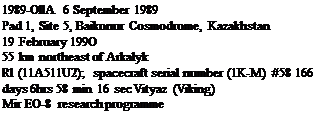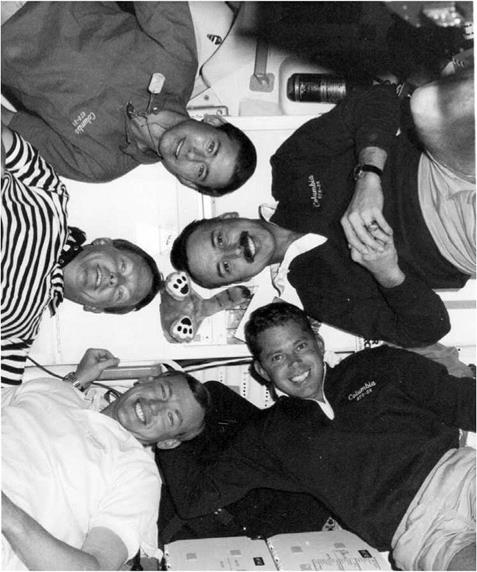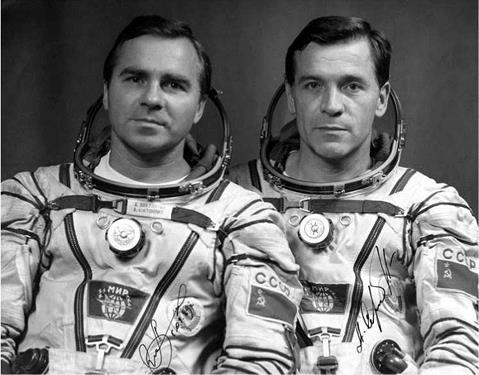STS-28
|
Int. Designation |
1989-061A |
|
Launched |
8 August 1989 |
|
Launch Site |
Pad 39B, Kennedy Space Center, Florida |
|
Landed |
13 August 1989 |
|
Landing Site |
Runway 17, Edwards Air Force Base, California |
|
Launch Vehicle |
OV-102 Columbia/ET-31/SRB BI-028/SSME #1 2019; |
|
#2 2022; #3 2028 |
|
|
Duration |
5 days 1 hr 0 min 9 sec |
|
Callsign |
Columbia |
|
Objective |
Fourth classified DoD Shuttle mission |
Flight Crew
SHAW, Brewster Hopkinson Jr., 44, USAF, commander, 3rd mission Previous missions: STS-9 (1983); STS 61-B (1985)
RICHARDS, Richard Noel, 42, USN, pilot ADAMSON, James C., 43, US Army, mission specialist 2 LEESTMA, David Cornell, 40, USN, mission specialist 1, 2nd mission Previous mission: STS 41-G (1984)
BROWN, Mark Neil, 38, USAF, mission specialist 3
Flight Log
In 1985, NASA announced the crew of a Department of Defense mission, STS 61-N, the last crew to be named before the Challenger disaster, which of course cancelled the mission. It eventually became known as STS-28, with one crew replacement. STS-28, by rights, should have taken off in late 1988 or early 1989, but the main reason for the delay to August 1989 was that the refurbishment of the oldest orbiter, Columbia, was taking much longer than anticipated. Columbia was being brought up to the standard of the later orbiters and even in early 1989 was short of 2,400 heatshield tiles. Other processing difficulties and parts shortages meant that the launch schedule had to be changed, with STS-33 moving to November to accommodate STS-28.
Columbia eventually reached the pad on 14 July and was ready to go at 07: 57 hrs local time on 8 August. Fog on the Shuttle runway at KSC took time to lift, so Columbia remained Earthbound for 40 minutes, leaving the pad at 08: 37 hrs, heading up the eastern seaboard of the USA into its 57° inclination orbit. On its fifth orbit, the crew deployed the advanced reconnaissance satellite KH-12 (USA-40). A smaller satellite was deployed the next day and the crew conducted classified experiments and one unclassified experiment on radiation monitoring before coming home to Edwards Air Force Base runway 17 at T + 5 days 1 hour 0 minutes 9 seconds, just after sunrise.
|
The STS-28 crew poses in the now-familiar “starburst” formation. Clockwise from top left: Shaw, Adamson, Leestma, Brown and Richards |
Later, it was reported that the KH-12 was spinning out of control in orbit and was inoperable. Apparently, however, the satellite was brought under control. The classified nature of the mission was lifted later, when a photo of the crew in orbit was released. This was the final re-qualification mission of the Shuttle fleet as part of the Return-to-Flight programme.
Milestones
126th manned space flight 60th US manned space flight 30th Shuttle mission 8th flight of Columbia 4th Shuttle DoD mission

 |
Flight Crew
VIKTORENKO, Aleksandr Stepanovich, 42, Soviet Air Force, commander, 2nd mission
Previous mission: Soyuz TM3 (1981)
SEREBROV, Aleksandr Aleksandrovich, 45, civilian, flight engineer,
3rd mission
Previous missions: Soyuz T1 (1982); Soyuz T8 (1983)
Flight Log
The Soviet Union’s premier space station, Mir, which was to have been permanently manned from February 1981 when the TM2 crew boarded her, remained empty for four months during 1989 as engineers readied the much-delayed add-on modules for launch so that future crews would have something more to do than use the Kvant telescopes and operate within the relatively cramped quarters of the Mir core module and Kvant. On 23 August 1989, there was a sure sign that Mir was being readied for another crew when a Progress was launched to dock with the station two days later. This was the first of a new series, called Progress M, a basic uprated version that would, according to the Soviets, carry a small re-entry vehicle to return 15O kg (331 lb) of samples in the future.
Soyuz TM8, which should have been launched the previous April, was readied on Pad 1, daubed for the first time with advertisements, and launched at 03: 38 hrs local time at Baikonur on 6 September, docking manually after a minor malfunction two days later. The commander was, as expected, Aleksandr Viktorenko, but his flight engineer was not Aleksandr Balandin of the TM8 that should have launched in April, but Aleksandr Serebrov, in space at last and sure that his new modules would be launched.
The first of these modules was to carry the first Soviet manned manoeuvring unit which Serebrov helped to develop. The launch of the first module, designated “D”, was due in October and the second, designated “T’’ later in the year. The first got off
|
The crew of Soyuz TM8: Victorenko (left) and Serebrov |
the ground much later than planned in 1989, but the second was delayed again, first to January then to Spring 1990, by which time another crew were scheduled to replace the TM8 crew, who were due to return to Earth on 19 February 1990. The delay to the “D” module from October to November was due to problems with checking it out for launch when several faults were found, a fact that was announced self-critically by Soviet officials.
The 19,565 kg (43,141 lb) module was finally launched on 26 November and was called Kvant 2. It gave a performance in space rather reminiscent of its predecessor in 1987. First, one of its two solar panels failed to deploy and there were suggestions that an EVA would be required to pull it out when the module arrived at Mir. Then the first docking attempt was called off at a distance of 20 km (12 miles) from the station because Kvant 2 was not in the right orbit. A subsequent attempt on 6 December was successful. The docking took place at the front port, replacing Progress M which had made the first front port unmanned tanker docking while TM8 was at the rear.
Kvant 2 was then ingeniously moved to a side port at the front by a simple cranelike device. TM8 moved back to the front after a crewed 20 minute fly around and was replaced at the rear by Progress M2 on 20 December, which for the first time carried a commercial US experiment to be operated by Soviet cosmonauts. Kvant 2 was fitted
with a wide EVA airlock, the MMU, scientific equipment, a remote-sensing camera and life support systems, including a shower.
On 9 January, Viktorenko and Serebrov made an EVA lasting 2 hours 56 minutes, using the Mir core module airlock, and moving as far as the rear of Kvant to install two 80 kg (176 lb) star sensors. A second EVA on 11 January, lasting 2 hours 54 minutes, made alterations to the docking port on Mir to receive the “T” module which was due in March. They also retrieved some materials left outside by the TM7 EVA cosmonauts. A third walk was completed on 26 January, and was the first to use the new wider airlock on Kvant 2. During the 3 hour 2 minute EVA, Viktorenko and Serebrov assembled a magnetic device on the outside of Kvant 2 on which the Icarus MMU could be placed during later planned spacewalks. The first of these came on 1 February, when Serebrov became the first Soviet to operate an MMU – which was tethered to Mir – moving as far as 33 m (108 ft) from the station. This 4 hour 59 minute EVA was followed on 5 February by a 3 hour 45 minute effort, during which Viktorenko also had a go on the MMU, extending the distance from Mir to 45 m (147 ft). Icarus weighed 220 kg (485 lb) and was powered by 32 compressed air thrusters, 16 of which were primary thrusters. Maximum speed available was 30m/sec (98ft/sec).
After cramming in the five spacewalks, which lasted a total of over 17 hours, the cosmonauts were joined by Anatoly Solovyov and Aleksandr Balandin in Soyuz TM9 on 13 February, and prepared to come home. They landed in biting winds and temperatures of—30° C 55 km (34 miles) northeast of Arkalyk at T + 166 days 6 hours 58 minutes, to a Soviet Union and Soviet bloc that had changed dramatically in such a relatively short time. This was the seventh longest manned space flight.
Milestones
127th manned space flight
67th Soviet manned space flight
60th Soyuz manned space flight
7th Soyuz TM manned space flight
15th Soviet and 38th flight with EVA operations
1st Soviet manned flight to operate commercial US experiments
1st Soviet test of MMU (tethered)
Serebrov celebrates his 46th birthday in space (15 Feb)












